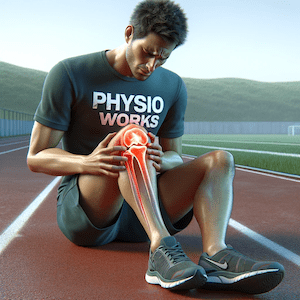Ligament Tear
Article by John Miller

Ligament Tear
Ligament Injuries, Recovery, and Prevention
What is a Ligament?
Ligaments, those robust, elastic bands of connective tissue, play a crucial role in connecting bones within a joint. They stabilise our movements and protect against excessive motion that could lead to injuries. But what happens when these structures themselves suffer damage?
What is a Ligament Tear?
A ligament tear, also known as a sprain, is not just an athlete’s plight; it can affect anyone. It typically occurs when a joint twists beyond its normal range, varying from mild irritation to severe pain and immobility.
Identifying Symptoms of a Ligament Tear
As physiotherapists, we often see patients with sudden, sharp pain, swelling, limited joint movement, bruising, or a tell-tale popping sound at the injury site. Quick assessment is vital, as the severity of the tear determines the treatment and recovery plan.
Grading the Severity of Ligament Tears
- Grade I Sprain: A mild strain where the ligament is stretched but intact. This causes minor pain and swelling.
- Grade II Sprain: A moderate tear with partial tearing of the ligament, leading to pain and joint instability.
- Grade III Sprain: The most severe form, where the ligament is completely ruptured, causing significant pain and instability.
Healing and Treatment: A Physiotherapist’s Approach
Ligaments have a blood supply that aids in healing, but the recovery time varies based on the tear’s severity and individual health. Treatment typically includes rest, ice, compression, elevation (RICE), physiotherapy, and anti-inflammatory medication.
Recovery Timeline
- Grade I Sprains: Generally, these heal within a few weeks with appropriate care and physiotherapy.
- Grade II Sprains: More serious, requiring 6 to 12 weeks for recovery, with gradual return to activities.
- Grade III Sprains: May necessitate surgery, with recovery spanning from 3 months to a year.

Common Ligament Injuries
Knee Ligaments
- ACL Injury: Typically occurs in sports from abrupt stops or directional changes.
- PCL Injury: Often from a direct impact to the bent knee’s front.
- MCL Injury: Can happen when a blow to the knee’s outer side forces it inward.
- LCL Injury: Results from a force to the knee’s inner side.
Ankle Ligaments
- Ankle Sprain: Involves tears in the ankle-supporting ligaments.
- High Ankle Sprain: Affects ligaments above the ankle and is more severe.
Shoulder Ligaments
- AC Joint Injury: Sprains or tears from a fall or blow to the shoulder.
- SLAP Lesion: Involves the shoulder’s labrum and associated ligaments.
- Glenohumeral Ligament Sprain: Can cause shoulder dislocation or instability.
Elbow & Wrist Ligaments
- Elbow Ligament Injury: Overstretched or torn ligaments from throwing actions.
- Wrist Sprain: Caused by falls or sudden twists, often leading to pain and swelling.
Spinal Ligaments
- Whiplash: Results from rapid back-and-forth neck movement, causing neck ligament injuries.
- Lumbar Sprain: Caused by overstretching or tearing lower back ligaments.
Innovations in Treatment: Cross Bracing
Recent research has highlighted the potential effectiveness of Cross bracing in treating ACL ligament injuries. This method provides additional support to the injured area, reducing stress on the healing ligament and aiding in faster recovery.
Strengthening Ligaments Post-Tear
Post-injury, it’s crucial to engage in recovery exercises to strengthen the ligaments. Tailored exercises, designed by a physiotherapist, help not only in recovery but also in preventing further injuries.
Final Thoughts on Ligament Tears
Suffering from a ligament tear can be a challenging experience. However, with proper exercises and professional guidance from a physiotherapist, sports doctor, or orthopaedic surgeon, you can achieve a full recovery. Don’t hesitate to seek their advice, as they can provide a tailored recovery plan based on the latest research and techniques, including innovative treatments like cross bracing.
Always remember, timely intervention and adhering to a structured recovery program play a pivotal role in overcoming a ligament tear. So, if you’re facing such an injury, make sure to consult your physiotherapist for the best course of action.
Related Articles
- Knee Ligament Injury – Physiotherapist Guide & Tips: Offers insights into knee pain, covering diagnosis, ACL injuries, meniscal injuries, and pain relief methods through exercise and treatment.
- ACL Injury – A Comprehensive Guide: Provides in-depth information on ACL injuries, including symptoms, treatment options, surgical considerations, and related knee injuries.
- Cross Bracing for ACL Injuries: Discusses the effectiveness of cross bracing in treating ACL ligament injuries and its role in recovery.
- Effective MCL Sprain Treatment and Prevention Tips: Focuses on MCL sprains, including severity assessment, symptoms identification, and consultation with professionals for knee injuries.
- PCL Injury: Discusses Posterior Cruciate Ligament (PCL) injuries, covering symptoms, diagnosis, and treatment options.
- Common Ankle Ligament Injuries: A Physiotherapist’s Guide: Explains various types of ankle ligament injuries, their symptoms, and treatment approaches.
- Shoulder Ligament Injuries: Provides information on different types of shoulder ligament injuries, including dislocation, AC joint injuries and SLAP lesions.
- Wrist Ligament Injuries: Offers insights into common injuries in these areas, including symptoms and treatment methods.
- Spinal Ligament Injuries: Focuses on injuries like whiplash and lumbar sprains, including their causes, symptoms, and treatment.
















































































